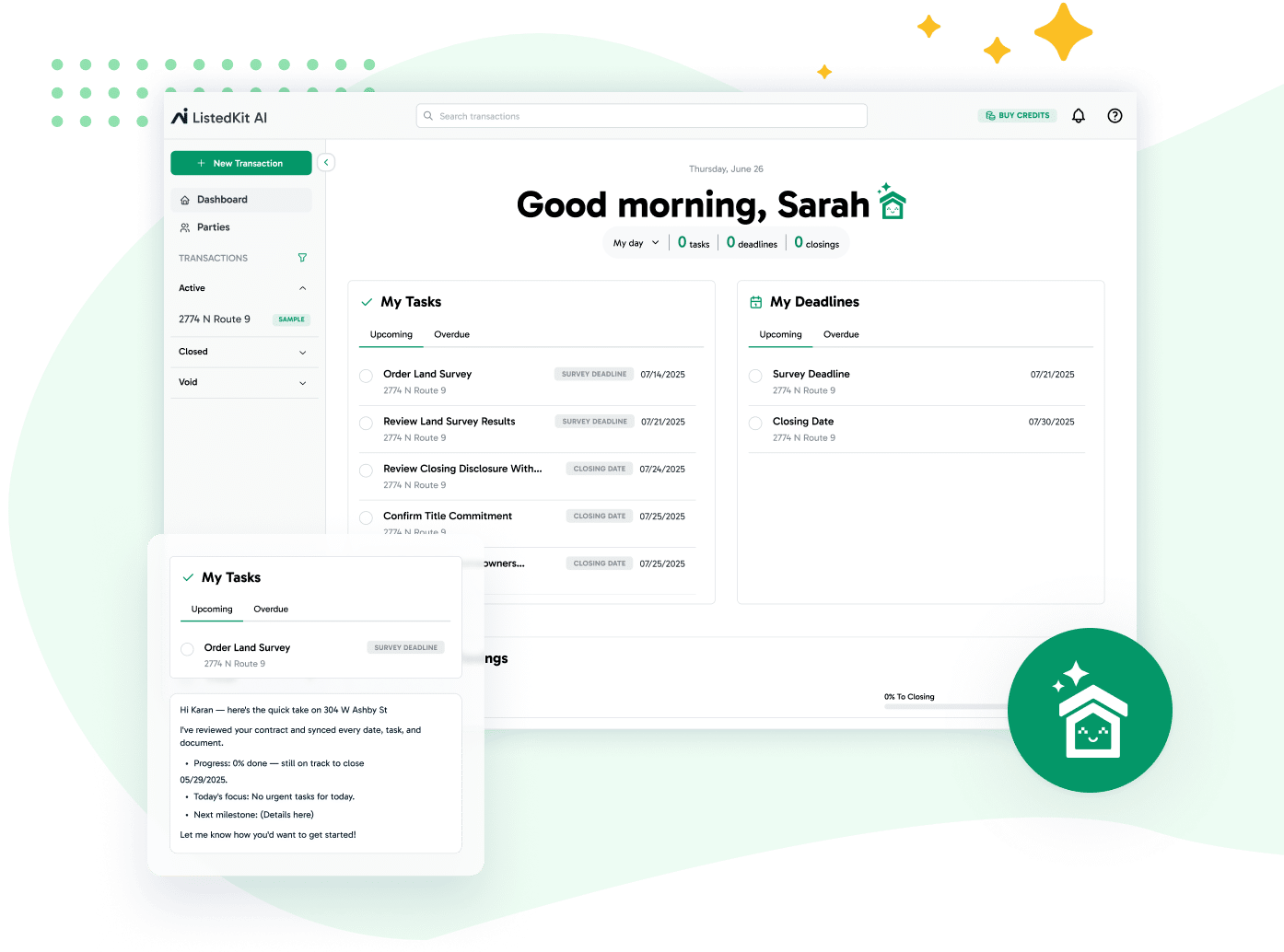When your real estate transaction system can’t adapt, the impact isn’t always loud but builds quickly. One missed update here, one extra manual step there, and before you know it, your day’s gone.
And while none of them seem urgent, they quietly drain your time, energy, and revenue potential.
If you don’t know how a rigid transaction management setup impacts your daily workload or bottom line, check out the seven ways it’s quietly eating into your time, profit, and capacity.
1. Manual Edits That Waste Hours and Slow Down Transactions
When your platform can’t adjust based on the kind of real estate transaction you’re handling, you make the same edits repeatedly.
For instance:
- You’re handling a cash deal, but your checklist still includes financing and appraisal tasks that have nothing to do with the timeline.
- A lease file lands on your desk, yet your system applies a standard purchase flow—missing tenant-specific steps like deposit tracking or lease-start coordination.
- You switch to a financed purchase, but now you’re scrambling to manually add lender communication, mortgage approval, and appraisal review tasks.
That repetitive editing slows your ability to scale and deliver a smooth transition across deal types.
In some cases, the issue even affects your client experience. You may be working with real estate professionals handling both buyers and sellers. They expect precision. A buyer on a 21-day close doesn’t want to wait while you sift through irrelevant finance tasks.
You also risk compliance issues when you leave unnecessary tasks in place or forget to remove outdated ones. Agents can get confused or think something was overlooked.
If you’re managing 20 to 30 real estate transactions and half need custom edits, you’re looking at hours of manual rework each week. Those hours should be spent reviewing key docs, managing vendor timelines, or attending networking events that expand your agent base.
2. Timeline Changes That Spiral Into Full-Day Fixes
Deadlines move. Inspection issues pop up. Title work drags.
Every timeline shift becomes a time-sink when your platform doesn’t adapt to these changes.
- Push a closing by five days? You’re now adjusting ten related tasks: final walkthroughs, document signings, and buyer communications.
- Reschedule an inspection? Your reminders, task deadlines, and even vendor coordination need manual fixes.
That kind of overhead creates fatigue. Not because the work is hard—but because it’s preventable.
Timing is Everything
Your pricing strategy depends on hitting key dates. When those slip, so do expectations. Sellers start asking questions, and buyers get antsy. Instead of adjusting one date, you’re manually realigning the entire file.
Even small delays can snowball in slower real estate markets or areas seeing more price reductions. A three-day push might knock you into a new calendar week—missing your window for showings, approvals, or even closing.
And if your system doesn’t shift those connected tasks automatically, the fix can cost you an entire afternoon.
You deserve real estate management tools that react the way a TC thinks: Task A depends on Task B, and if B moves, A should adjust accordingly. That’s not a luxury—it’s a basic requirement for keeping momentum in motion.
3. No Room for Agent-Specific Workflows
Every agent has their rhythm. Some want a summary every Friday at noon. Others want you to text as soon as the inspection is booked. You know how to adapt, but it shouldn’t fall outside your workflow.
Rigid systems that lack agent-level customization force you to:
- Send manual updates for agents who don’t like the default cadence.
- Rewrite emails just to change the tone or branding for each person.
- Keep side documents or personal notes just to track communication preferences.
When you manage 10+ real estate agents with distinct personalities, the task quickly becomes a web of side tasks. You’re not coordinating; you’re compensating.
This also limits how many agents you can realistically serve. If your system can’t scale your communication, your growth caps out, no matter how fast your market moves.
Communication delays also affect client satisfaction. You might’ve hit every milestone, but if your agent doesn’t feel informed, it can still impact your professional reputation.
As market realities shift and buyer expectations tighten, consistency in communication is no longer optional. You need tools that adapt to the deal and the person managing it.
4. Bottlenecks from Limited Access and Over-Control
Some systems keep control so tight that no one else can touch anything. They sound secure until they become the bottleneck.
- Agents can’t upload their disclosures or sign off on tasks, so they email you—then you upload, assign, and confirm.
- Clients don’t know where they are in the process, so they send you messages asking the same questions multiple times.
- Vendors (appraisers, title reps, inspectors) ask for updates you’ve already logged, but they can’t see them.
When your transaction platform doesn’t allow real estate professionals to interact with the file in meaningful ways, you become the point person for everything. That’s fine for five deals, but it’s unsustainable at scale.
You enter data twice—once when you receive it and once when you upload or assign it. This can lead to mistakes, missed uploads, and delayed confirmations.
Worse, the delay in visibility creates confusion. If a potential buyer calls their agent and asks what’s next, and that agent doesn’t have access to the latest update, everyone loses trust.
5. Compliance Risks Hidden in One-Size-Fits-All Templates
State and brokerage differences are legal requirements. If your checklist doesn’t reflect local expectations, you’re at risk.
- A California file might require a wildfire disclosure. A Texas file might need different option period handling.
- Some brokerages demand in-house compliance audits or special internal sign-offs. Others operate with more flexibility.
- If your templates don’t adjust to these variables, you keep mental notes—or worse, recheck policies every time.
When your templates don’t shift based on geographic location or broker policy, you absorb the cost. That cost shows up as:
- Duplicate checklists to manage different compliance tracks.
- Missed tasks or delays due to manual updates.
- Avoidable errors that put the successful transaction at risk.
Your system should support the market knowledge you already have.
Real estate markets vary by state and county. Relying on rigid templates can lead to missed deadlines, last-minute scrambling, and unneeded tension between agents and coordinators.
6. Messaging Limitations That Cost You Time and Credibility
Communication matters. A fast update, sent clearly and on time, builds confidence. But some platforms make that harder than it should be.
- You’re stuck with hardcoded messages that don’t reflect your tone or branding.
- You can’t insert dynamic fields like “property address” or “loan approval date,” so you rewrite the message manually.
- You waste time retyping or copying from old emails when all you want is to send a quick check-in.
This is about protecting your market position with agents and clients alike. Fast, accurate updates create a positive impression. Meanwhile, slow, repetitive comms signal disorganization.
Templates should be tools, not obstacles. Your baseline should be the ability to send accurate, relevant updates in one click.
7. Rigid Automation That Blocks Growth Instead of Supporting It
Automation works when it’s responsive. The problem with many systems is that they offer automation that only fits a single mold.
Here’s what that looks like:
- You can’t add conditions for cash vs. financed deals, so every checklist looks the same.
- You can’t link email triggers to task completion, so you send them manually.
- You can’t pause or shift deadlines automatically when a task stalls.
That inflexibility costs you time and financial strain when you have to hire help for tasks your platform could’ve handled.
You might be managing deals with real estate investors, some of whom are flipping properties and want rapid updates.
Others are passive investors who want end-of-week summaries. You’re juggling expectations outside your workflow if your system can’t handle both.
Flexible automation also affects variable expenses. Every extra hour you spend managing what could be automated is time you’re not spending on higher-return work, like new file onboarding or property offer tracking.
What a Flexible Real Estate Transaction System Looks Like
A flexible system keeps your process clear, even as deal types change. It helps you simplify.
Look for features that allow you to:
- Build templates that match each transaction type without starting from scratch
- Trigger automation based on real events like a revised closing date or updated inspection timeline
- Set agent-specific communication preferences once and apply them automatically across every file
Flexibility should also support growth. If managing more agents or files makes things harder instead of easier, the system isn’t built for scale.
You’ll notice flexibility in the details:
- Fewer tabs open to track one transaction
- Fewer repetitive edits across your task list
- Fewer updates falling outside your system
A real estate transaction management system that supports how you work helps reduce distractions, keeps tasks visible, and gives others access without making you the bottleneck. That’s what real support looks like.
Stop Working Around an Inflexible System, Build One That Works for You
Rigid systems slow you down, quietly reduce your capacity, drain energy, and leave little room for growth.
If your workflow constantly needs fixing, it’s worth asking whether the tools you’re using are part of the problem.
Remember that these are the seven ways rigid real estate transaction systems hurt your time and profit—day in and day out:
- Manual edits across deal types eat into your hours and reduce your consistency.
- Timeline delays turn into expensive rework when your system doesn’t adjust automatically.
- Agent-specific preferences are hard to manage when the platform can’t adapt.
- Limited access and control create unnecessary bottlenecks and duplicated tasks.
- State and brokerage requirements get missed when templates don’t reflect local rules.
- Poor communication tools slow down updates and weaken client trust.
- Rigid automation means doing more work by hand, costing you time and capacity.
Design a system and use a good real estate transaction management tool that reflects your work style. The one that adjusts to the deal type, keeps your agents informed, supports compliance, and gives you time back instead of taking more of it.




